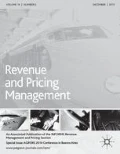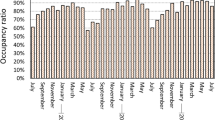Abstract
The New Distribution Capability and new retailing platforms will enable airlines to respond to shopping requests with bundled offers of flights and ancillary services, representing an evolution from traditional, flight-focused optimization. Assembling an attractive set of offers to display to customers therefore represents a new joint pricing and assortment optimization problem in airline revenue management. In this paper, we introduce an initial optimization approach for the selection and pricing of a la carte and bundled flight and ancillary offers. First, we propose a customer choice model that captures the impact of ancillary bundles on flight itinerary choice. We then calculate prices for each offer from a continuous range of price points and display the offer set that maximizes expected revenue for a given customer segment. We illustrate the approach using a single-flight, single-ancillary base case and discuss extensions to more complex environments. Tests in the Passenger Origin–Destination Simulator (PODS) show that dynamic offer generation (DOG) can increase net revenue when used by one or more airlines in a competitive network, assuming that the airlines are able to accurately segment incoming requests and estimate the average willingness-to-pay of each segment. We find that the majority of the revenue gains of DOG are due to competitive effects from the dynamic pricing of the flight component of the offer. The bundling mechanism of DOG is a secondary source of revenue gain that can be realized when customers take bundled ancillary services into account when choosing the flight. Our results provide insight for practitioners that are implementing offer optimization systems and processes. For example, in line with the previous literature on bundle pricing, we find that in transparent distribution channels an ancillary service should be bundled with the flight when the valuation for the ancillary is high or when its marginal cost of provision is low. We close by discussing the strategic and managerial implications of a move from traditional distribution strategies to a next-generation, offer-focused approach.













Similar content being viewed by others
References
Adams, W.J., and J.L. Yellen. 1976. Commodity bundling and the burden of monopoly. The Quarterly Journal of Economics 90 (3): 475–498.
Belobaba, P. and C. Hopperstad. 2004. Algorithms for revenue management in unrestricted fare markets. Presentation at AGIFORS Reservations and Yield Management Study Group.
Bockelie, A. 2019. Ancillary services in the airline industry: Passenger choice and revenue management optimization. PhD thesis, Massachusetts Institute of Technology, https://hdl.handle.net/1721.1/121879.
Bockelie, A., and P. Belobaba. 2017. Incorporating ancillary services in airline passenger choice models. Journal of Revenue and Pricing Management 16: 553–568.
Cataldo, A., and J.-C. Ferrer. 2017. Optimal pricing and composition of bundles: A two-step approach. European Journal of Operations Research 259: 766–777.
Dezelak, M., and R. Ratliff. 2018. Towards new industry-standard specifications for air dynamic pricing engines. Journal of Revenue and Pricing Management 17: 394–402.
Dobson, G., and S. Kalish. 1988. Positioning and pricing a product line. Marketing Science 7 (2): 107–125.
Ellison, G. 2005. A model of add-on pricing. The Quarterly Journal of Economics 120 (2): 585–637.
Fiig, T., K. Isler, C. Hopperstad, and P. Belobaba. 2010. Optimization of mixed fare structures: Theory and applications. Journal of Revenue and Pricing Management 9 (1): 152–170.
Fiig, T., R. Härdling, S. Pölt, and C. Hopperstad. 2014. Demand forecasting and measuring forecast accuracy in general fare structures. Journal of Revenue and Pricing Management 13: 413–439.
Fiig, T., O. Goyons, R. Adelving, and B. Smith. 2016. Dynamic pricing—The next revolution in RM? Journal of Revenue and Pricing Management 15: 360–379.
Fiig, T., R. Le. Guen, and M. Gauchet. 2018. Dynamic pricing of airline offers. Journal of Revenue and Pricing Management 17: 381–393.
Gabaix, X., and D. Laibson. 2006. Shrouded attributes, consumer myopia, and information suppression in competitive markets. The Quarterly Journal of Economics 121 (2): 505–540.
Hanson, W., and R.K. Martin. 1990. Optimal bundle pricing. Management Science 36 (2): 155–174.
Hao, E. 2014. Ancillary revenues in the airline industry: impacts of revenue management and distribution. Master’s thesis, Massachusetts Institute of Technology, http://hdl.handle.net/1721.1/89854.
Jagabathula, S., and P. Rusmevichientong. 2017. A nonparametric joint pricing and assortment optimization model. Management Science 63 (9): 3128–3145.
Kumar, R., A. Li, and W. Wang. 2018. Learning and optimizing through dynamic pricing. Journal of Revenue and Pricing Management 17: 63–77.
Madireddy, M., R. Sundararajan, G. Doreswamy, M.H. Nia, and A. Mital. 2017. Constructing bundled offers for airline customers. Journal of Revenue and Pricing Management 16: 532–552.
Newman, J., M. Ferguson, L. Garrow, and T. Jacobs. 2014. Estimation of choice-based models using sales data from a single firm. Manufacturing & Service Operations Management 16 (2): 184–197.
Ødegaard, F., and J.G. Wilson. 2016. Dynamic pricing of primary products and ancillary services. European Journal of Operations Research 251: 586–599.
Schmalensee, R. 1984. Gaussian demand and commodity bundling. The Journal of Business 57 (1–2): 211–230.
Shao, S., and G. Kauermann. 2020. Understanding price elasticity for airline ancillary services. Journal of Revenue and Pricing Management 19: 74–82.
Shukla, N., A. Kolbeinsson, K. Otwell, L. Marla, and K. Yellepeddi. 2019. Proceedings of the 25th ACM SIGKDD International Conference on Knowledge Discovery & Data Mining, pp. 2174–2182.
Shulman, J.D., and X. Geng. 2013. Add-on pricing by asymmetric firms. Management Science 59 (4): 899–917.
Smith, B. C. and C. W. Penn. 1988. Analysis of alternate origin-destination control strategies. Proceedings of the Twenty Eighth Annual AGIFORS Symposium.
Talluri, K., and G. van Ryzin. 2004. Revenue management under a general discrete choice model of consumer behavior. Management Science 50 (1): 15–33.
Vinod, B., R. Ratliff, and V. Jayaram. 2018. An approach to offer management: Maximizing sales with fare products and ancillaries. Journal of Revenue and Pricing Management 17: 91–101.
Wang, K.K. 2020. Airline revenue management with dynamic offers: Bundling flights and ancillary services. Master’s thesis, Massachusetts Institute of Technology, https://hdl.handle.net/1721.1/127110.
Westermann, D. 2013. The potential impact of IATA’s New Distribution Capability (NDC) on revenue management and pricing. Journal of Revenue and Pricing Management 12 (6): 565–568.
Wittman, M.D., and P. Belobaba. 2018. Customized dynamic pricing of airline fare products. Journal of Revenue and Pricing Management 17 (2): 78–90.
Wittman, M.D., and P.P. Belobaba. 2019. Dynamic pricing mechanisms for the airline industry: A definitional framework. Journal of Revenue and Pricing Management 18: 100–106.
Acknowledgements
The opinions expressed in this paper represent those of the authors only and do not necessarily reflect the positions of their respective employers. The authors are grateful to Peter Belobaba and the members of the MIT PODS Consortium for financial support and for their ideas that culminated in this paper, and to Matthew Berge for assisting with development. We also thank Thomas Fiig and Richard Cléaz-Savoyen for reviewing the paper and offering their thoughtful feedback.
Author information
Authors and Affiliations
Corresponding author
Additional information
Publisher's Note
Springer Nature remains neutral with regard to jurisdictional claims in published maps and institutional affiliations.
Rights and permissions
About this article
Cite this article
Wang, K.K., Wittman, M.D. & Bockelie, A. Dynamic offer generation in airline revenue management. J Revenue Pricing Manag 20, 654–668 (2021). https://doi.org/10.1057/s41272-021-00349-4
Received:
Accepted:
Published:
Issue Date:
DOI: https://doi.org/10.1057/s41272-021-00349-4




